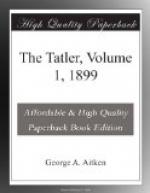If more is said here of Steele than of Addison, it is because it is Steele whose name is most intimately connected with the Tatler. The field in which Addison shone brightest was the Spectator, where the whole plan was arranged in the manner best suited to his genius. But his influence is, nevertheless, visible in the development of the earlier paper, and some of his individual articles are equal to anything he afterwards wrote. It is only necessary to mention his papers on the Distress of the News-Writers[5]; on the poetaster, Ned Softly[6]; on the pedant and “broker in learning,” Tom Folio[7]; on the Political Upholsterer, who was more inquisitive to know what passed in Poland than in his own family[8]; and on the Adventures of a Shilling.[9] His, too, are the Vision of Justice[10]; the story of a dream;[11] and the amusing account of the visit to London of Sir Harry Quickset, who, with his old-world breeding, was the forerunner of Sir Roger de Coverley.[12]
Unlike the members of the Spectator’s Club, the dramatis personae introduced in the Tatler do not occupy a very prominent place in the development of the work. Isaac Bickerstaff himself, an old man of sixty-four, “a philosopher, an humourist, an astrologer, and a censor,” is rather vaguely sketched, and his familiar, Pacolet, is made use of chiefly in the earlier numbers. The occasional references to Bickerstaff’s half-sister, Jenny Distaff,[13] and her husband, Tanquillus, and to his three nephews and their conduct in the presence of a “beautiful woman of honour,"[14] gave Steele a framework for some charming sketches of domestic life. It is not until No. 132 that we have the amusing account of the members of Bickerstaff’s Club, the Trumpet, in Shire Lane. There were Sir Geoffrey Notch, a gentleman of an ancient family, who had wasted his estate in his youth, and called every thriving man a pitiful upstart; Major Matchlock, with his reminiscences of the Civil War; Dick Reptile, and the Bencher who was always praising the wit of former days, and telling stories of Jack Ogle, with whom he pretended to have been intimate in his youth. Very little use was afterwards made of this promising material.




